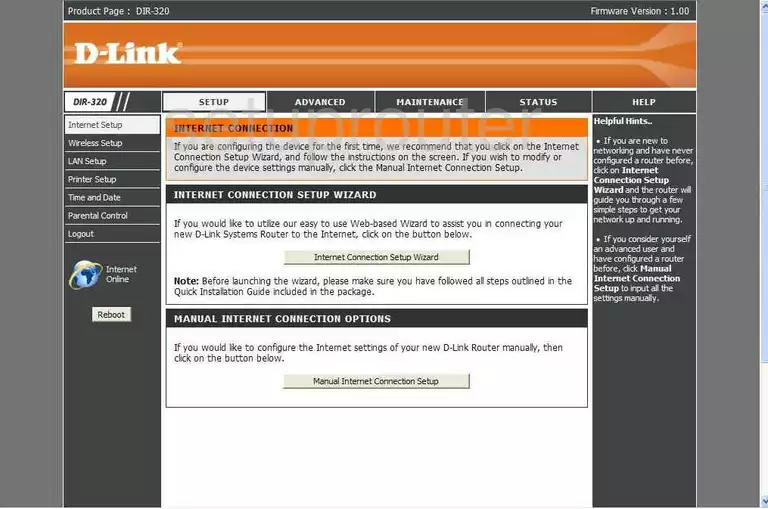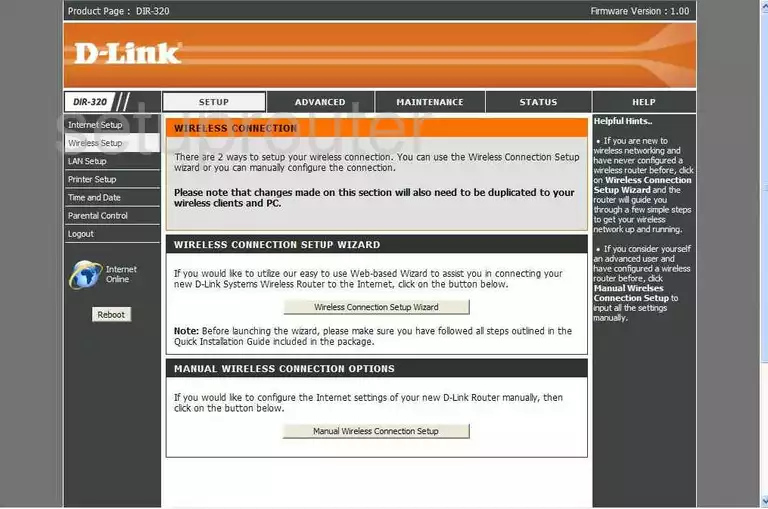The Dlink DIR-320 router is considered a wireless router because it offers WiFi connectivity. WiFi, or simply wireless, allows you to connect various devices to your router, such as wireless printers, smart televisions, and WiFi enabled smartphones.
Other Dlink DIR-320 Guides
This is the wifi guide for the Dlink DIR-320. We also have the following guides for the same router:
- Dlink DIR-320 - How to change the IP Address on a Dlink DIR-320 router
- Dlink DIR-320 - Dlink DIR-320 Login Instructions
- Dlink DIR-320 - Dlink DIR-320 User Manual
- Dlink DIR-320 - Dlink DIR-320 Port Forwarding Instructions
- Dlink DIR-320 - How to Reset the Dlink DIR-320
- Dlink DIR-320 - Information About the Dlink DIR-320 Router
- Dlink DIR-320 - Dlink DIR-320 Screenshots
WiFi Terms
Before we get started there is a little bit of background info that you should be familiar with.
Wireless Name
Your wireless network needs to have a name to uniquely identify it from other wireless networks. If you are not sure what this means we have a guide explaining what a wireless name is that you can read for more information.
Wireless Password
An important part of securing your wireless network is choosing a strong password.
Wireless Channel
Picking a WiFi channel is not always a simple task. Be sure to read about WiFi channels before making the choice.
Encryption
You should almost definitely pick WPA2 for your networks encryption. If you are unsure, be sure to read our WEP vs WPA guide first.
Login To The Dlink DIR-320
To get started configuring the Dlink DIR-320 WiFi settings you need to login to your router. If you are already logged in you can skip this step.
To login to the Dlink DIR-320, follow our Dlink DIR-320 Login Guide.
Find the WiFi Settings on the Dlink DIR-320
If you followed our login guide above then you should see this screen.

Starting on the Internet Setup page of the Dlink DIR-320 router, click the link on the left side of the page labeled Wireless Setup.
Change the WiFi Settings on the Dlink DIR-320

This takes you to the page you see here. First click the button in the lower center of the page labeled Manual Wireless Connection Setup.
This takes you to a page that unfortunately we do not have. At the top of this new page, is WPS or Wi-Fi Protected Setup. We highly recommend not using this option. Please read our What is WPS Guide.
The next section is titled Wireless Network Settings. First, find the Wireless Network Name. This is the SSID or the name you create to identify your network from those around you. Be creative but avoid using personal information. Take a look at our Wireless Names Guide for more information on this topic.
To change the Channel you first need to uncheck the box titled Enable Auto Channel Selection. Then in the pull-down menu next to Channel, choose the channel you want to use. Make sure to use one of the three non-overlapping channels in the spectrum, they are channels 1,6, and 11. To learn more about why you should only be using these three channels, read our WiFi Channels Guide.
Now drop down to the next section titled Wireless Security Mode. Use the pull-down list called Security Mode to choose the option of Enable WPA2 Only Wireless Security. This is the most secure option available for home networks. To learn more about the different security modes, read our WEP vs. WPA Guide.
A new section should appear called WPA Only or possibly WPA2 Only. In this section use the Cipher Type pull-down menu to choose AES. AES is considered the most secure option available.
Next is the choice of PSK/EAP. Select the option of PSK.
Now enter the Network Key. This is the password or the PSK you use to gain access to your wireless network. We recommend using at least 14-20 characters. Create a strong password with some symbols, numbers, and capital letters in it. Don't use words that can be found in a dictionary. To learn more about creating a strong and memorable password, read our Choosing a Strong Password Guide.
Finally, click the Save Settings button before you exit.
Possible Problems when Changing your WiFi Settings
After making these changes to your router you will almost definitely have to reconnect any previously connected devices. This is usually done at the device itself and not at your computer.
Other Dlink DIR-320 Info
Don't forget about our other Dlink DIR-320 info that you might be interested in.
This is the wifi guide for the Dlink DIR-320. We also have the following guides for the same router:
- Dlink DIR-320 - How to change the IP Address on a Dlink DIR-320 router
- Dlink DIR-320 - Dlink DIR-320 Login Instructions
- Dlink DIR-320 - Dlink DIR-320 User Manual
- Dlink DIR-320 - Dlink DIR-320 Port Forwarding Instructions
- Dlink DIR-320 - How to Reset the Dlink DIR-320
- Dlink DIR-320 - Information About the Dlink DIR-320 Router
- Dlink DIR-320 - Dlink DIR-320 Screenshots